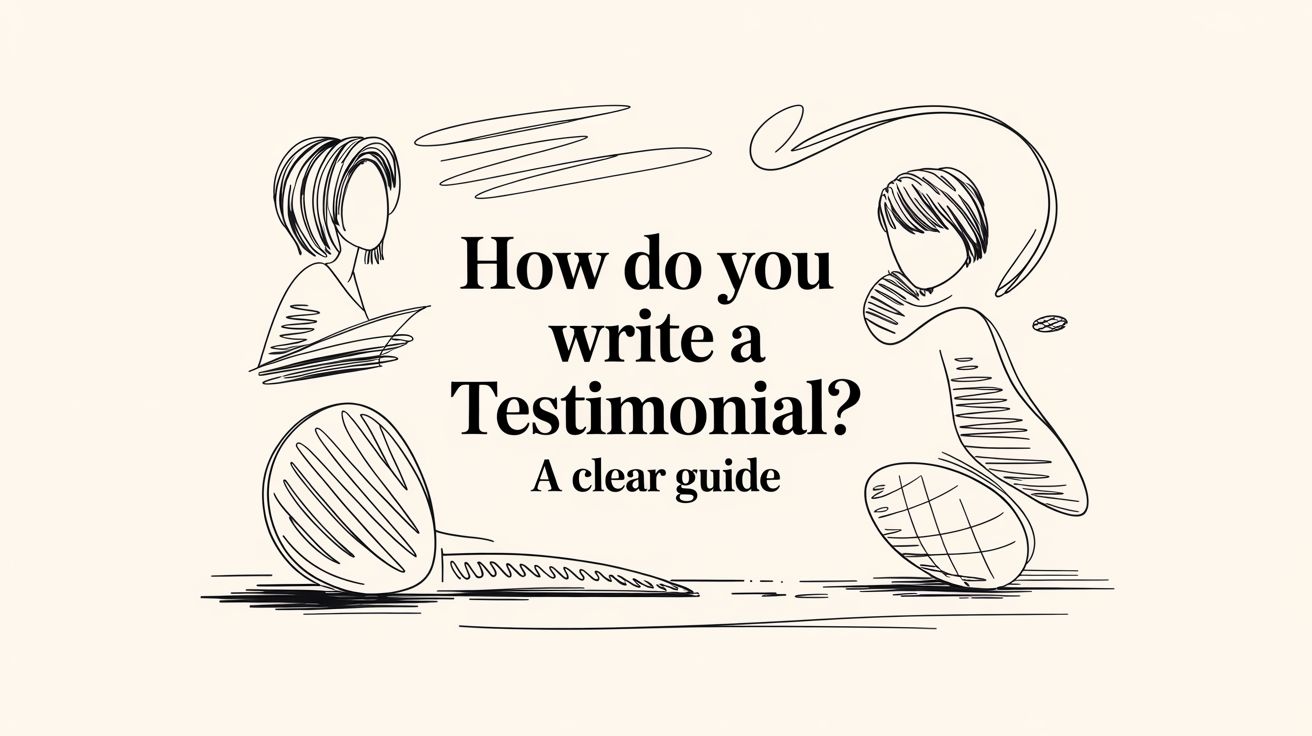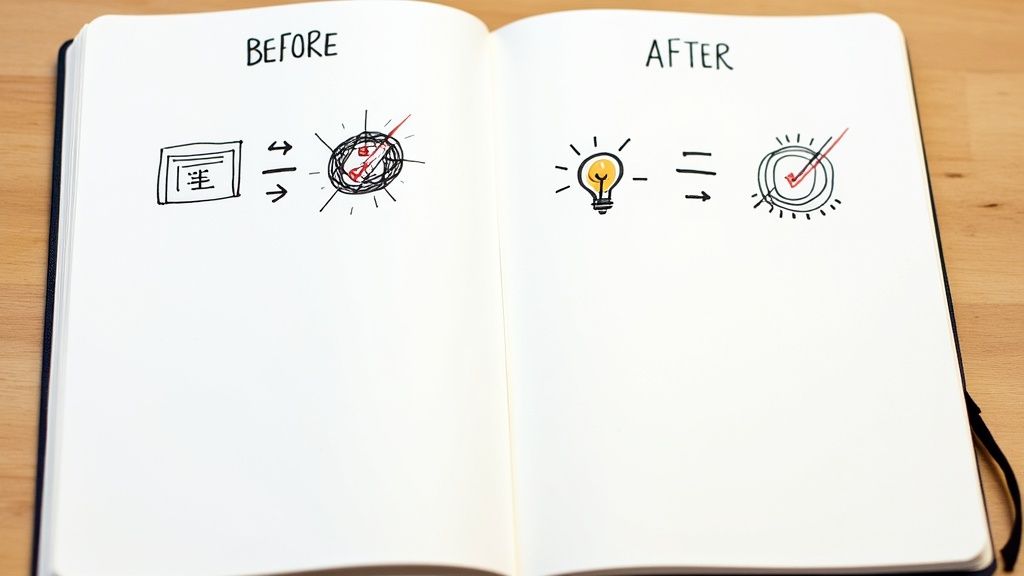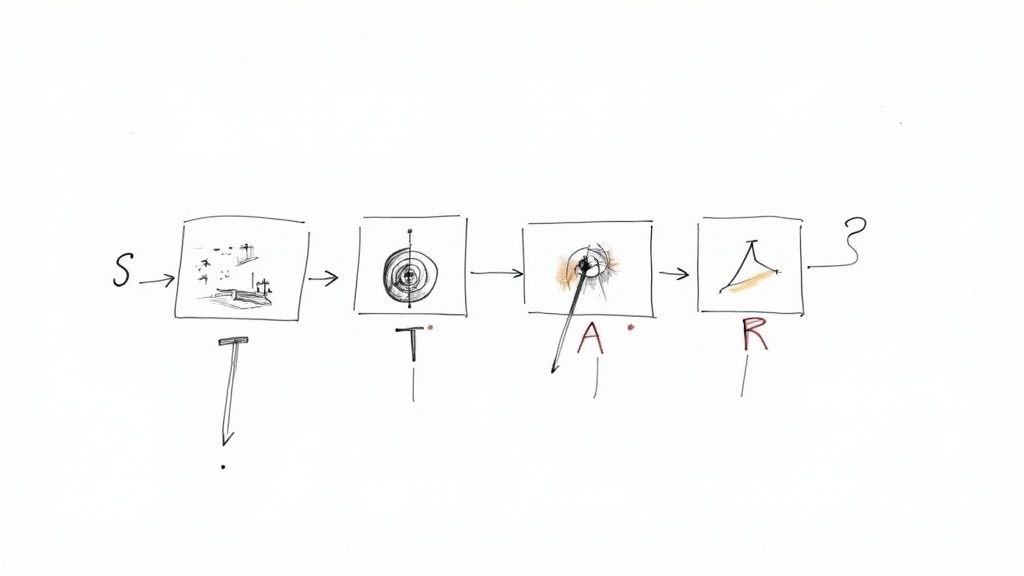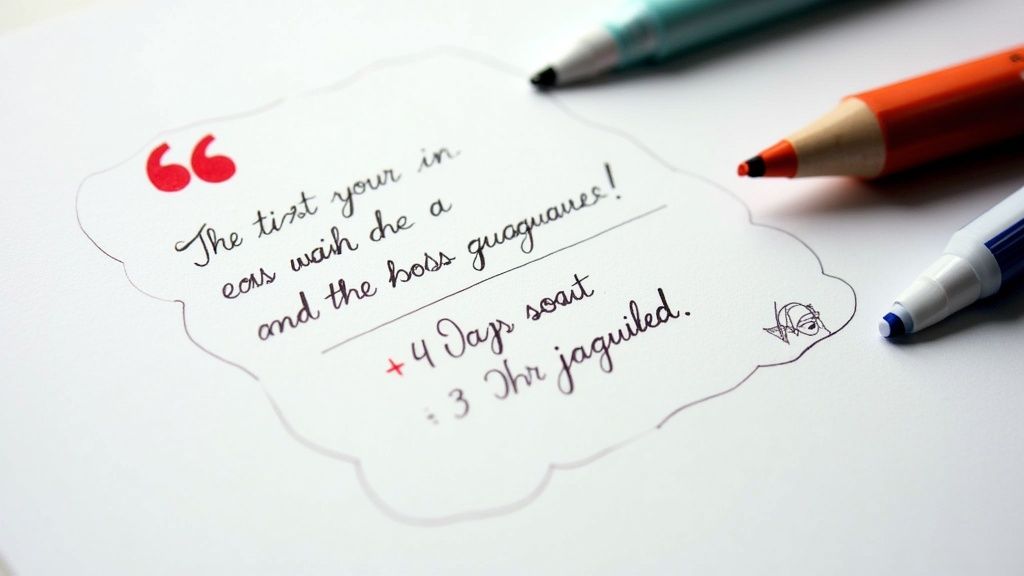How do you write a testimonial? A Clear Guide

Knowing how to write a good testimonial is about understanding its real power. Your story isn't just a simple thank-you note; it's a powerful piece of social proof that builds a bridge of trust between a business and its future customers. It often gives them that final nudge they need to make a confident choice. Ready to start collecting testimonials for your business? Check out Good Kudos to see how easy it can be.
Why Your Testimonial Is More Than Just a Review

Before you even start writing, it’s important to realise the weight your words carry. A well-crafted testimonial cuts right through all the marketing noise. It speaks directly to potential customers in a language they actually trust—the voice of a real person.
Your firsthand experience offers an authentic peek into the real-world value of a product or service. Think about it: a company can list its features all day long, but only a customer can describe the feeling of a nagging problem finally being solved. That personal narrative is incredibly persuasive.
The Power of Authentic Customer Stories
In today's market, peer reviews have become a cornerstone of brand reputation. This is especially true for UK consumers, where online reviews now hold far more influence than traditional advertising. Things like product quality and customer service are best communicated through genuine, honest feedback.
Your perspective provides things that a business just can't fake:
- Authenticity: It shows a real person has used and benefited from the service.
- Credibility: It backs up the company's marketing claims with tangible proof.
- Relatability: It helps potential customers see themselves in your success story.
A great testimonial doesn't just praise; it explains. It transforms a generic "five-star" rating into a compelling story of before-and-after, providing the context and detail that truly helps others.
Ultimately, your feedback acts as a guide for others who are trying to make their own decisions. By sharing your experience, you contribute to a more transparent and trustworthy marketplace for everyone.
Writing a great review is a skill. And for businesses, collecting these powerful stories is simple with platforms like Good Kudos, which streamlines the entire process of gathering valuable customer feedback. This guide will set you up to craft a testimonial that is not just positive, but genuinely helpful and influential.
How to Organise Your Thoughts for a Powerful Story

Before you even think about writing, just pause for a moment. A truly great testimonial isn’t about just putting words on a page; it starts with organising your thoughts. A little bit of prep work is what turns a vague "it was great" into a detailed, impactful story that actually connects with people.
Your goal here is to build a narrative bridge, connecting the problem you had with the solution you found. Think of it like painting a clear "before and after" picture. The best place to start is by recalling the specific challenge you were up against. What did that struggle really look like day-to-day?
Identifying Your 'Before' State
To get to the heart of it, ask yourself a few key questions. Don’t just think about the problem itself, but about the ripple effects it had. This is how you uncover the details that make a story feel real and compelling.
- What was the main frustration or obstacle you were dealing with?
- How did this issue impact your work, your time, or even your stress levels?
- What other solutions had you already tried that just didn't cut it?
Thinking back on these details helps you set a relatable scene for your story. It establishes the stakes, which makes the positive outcome you’re about to share feel that much more significant.
Pinpointing the 'After' Transformation
Now, let's flip the script and focus on the solution. What was the turning point? Describe the tangible results you saw. Maybe it was one standout feature, a specific metric that shot up, or a genuinely helpful chat with the support team.
Speaking of which, exceptional customer service can be a powerful angle for your feedback. In the UK, where nearly half of consumers reported a poor customer service experience in a recent year, a positive story really stands out. Highlighting great support builds a massive amount of trust. You can find out more by reading about UK consumer behaviour insights.
By spending just a few minutes organising your thoughts, you can easily recall the specific, credible details that make your testimonial genuinely helpful and persuasive.
This simple structure gives you the backbone for an authentic narrative. And for businesses looking to capture these kinds of powerful stories, platforms like Good Kudos make it effortless to collect and showcase genuine customer feedback.
Structuring Your Narrative with the STAR Method

So, you've jotted down a few thoughts. Now it's time to shape them into something that truly resonates. The best way I’ve found to do this is with the STAR method.
It’s a dead-simple framework that helps you turn a simple comment into a compelling story. It gives your experience a clear beginning, middle, and end, making sure your testimonial is logical, persuasive, and incredibly easy for a potential customer to follow.
The whole point is to move beyond generic praise like "it was great!" and provide the kind of context that makes your feedback genuinely valuable.
Let's break down what each part looks like.
Situation and Task: The Foundation of Your Story
First up, you need to set the scene with the Situation. This is your "before" picture. What specific challenge were you banging your head against before you found this product or service? This is what makes your story relatable.
Next comes the Task. What exactly did you need to achieve? This defines your goal and gives the reader a clear understanding of what a "win" would look like for you.
Action and Result: The Heart of Your Testimonial
Now for the good stuff. The Action is where you explain the specific steps you took using the product. This is your chance to get into the how. Instead of just saying "it worked," you can describe the exact features you used or the process that made a difference.
Finally, the Result. This is the grand finale, the "after" picture that proves the value of your experience. The more specific you can be here, the more powerful it becomes. Did you save 10 hours a week? Did you boost your sales by 30%? Did you just feel a lot less stressed? This is the proof in the pudding.
Using the STAR method transforms your feedback from a simple comment into a powerful case study. It gives your story a beginning, a middle, and an end, making it much more memorable and impactful for potential customers.
To make it even clearer, here’s a simple table to guide you as you write.
Using the STAR Method for Your Testimonial
This simple breakdown of the STAR method gives you helpful prompts to guide your writing for each stage.
| Component | What to Write About | Helpful Prompt |
|---|---|---|
| Situation | The specific problem or challenge you faced. | "Before using this, we were struggling with..." |
| Task | The specific goal you needed to accomplish. | "My main goal was to find a way to..." |
| Action | How you used the product/service to meet the goal. | "I used [specific feature] to..." |
| Result | The specific, positive outcome you achieved. | "As a result, we saw a..." |
Thinking about your experience this way makes the whole writing process feel much less daunting.
For businesses on the other side of this, making it easy for customers to provide this kind of structured feedback is a game-changer. Platforms like Good Kudos help you collect these detailed, story-driven testimonials without any friction, turning genuine customer success into your most powerful marketing asset.
Adding Specific Details That Build Credibility

Let's be honest, "great service" is nice to hear, but it doesn't really do anything. It’s forgettable. What really makes a testimonial hit home are the specific, juicy details. That's what gives your story weight and transforms it from a polite nod into a powerful piece of social proof.
Vague compliments are fine, but they won’t convince someone on the fence. Specifics, on the other hand, build a bridge of trust. They answer the silent questions and doubts a potential customer is wrestling with.
Weave in Quantifiable Results
Whenever you can, lead with numbers. Why? Because numbers don't lie. They provide cold, hard proof of the impact a product or service had on you, and that kind of evidence is incredibly persuasive.
Think about the tangible changes you saw:
- Did you boost your team’s efficiency by 25%?
- Are you now saving five hours every single week on tedious admin?
- Did you see a specific jump in revenue after you started using the service?
Even small numbers can paint a surprisingly powerful picture. They turn a subjective opinion into an objective outcome that genuinely clicks with someone looking for a real solution.
Describe Qualitative Benefits Vividly
Of course, not every benefit can be boiled down to a number, and that's okay. Qualitative wins—like less stress or a happier team—can be just as compelling, but you have to describe them in a way that people can feel.
Instead of saying, "It made my job easier," show them what that looks like. Try something like, "Our weekly planning meetings used to be chaotic. Now, everyone shows up aligned, and we’re done in half the time with a crystal-clear plan." See? You just painted a picture.
Specifics are the backbone of a trustworthy testimonial. Whether it's a hard number or a well-described feeling, detail is what separates a forgettable review from a persuasive one.
Another great trick is to focus on one or two key features that made the biggest difference for you. When you explain why something worked, you’re not just praising it; you’re giving others the insight they need to make their own informed decision.
For businesses trying to collect these kinds of stories, a simple tool like Good Kudos can make all the difference. It makes it effortless for your happy customers to share the specific details that turn their success into your best marketing asset.
Right, you’ve got the core of your story down. Now it’s time for the final polish. This is where we turn a good draft into a testimonial that genuinely connects with people and makes them sit up and take notice.
First impressions really do matter, so let's look at your opening line. Instead of a generic start like "This product was great," lead with your biggest win. What was the most impressive result you got? What was the core problem it solved for you? Kicking things off with that immediately hooks the reader and makes them want to know how you got there.
A Few Final Checks for a Clear, Believable Review
Keep your sentences short and punchy. You’re not writing an essay; you’re sharing a real experience. Long, winding sentences can water down your message, but short, clear ones are easy to scan and feel much more direct. Give it a quick once-over for any glaring typos or grammar mistakes, too – a little bit of care makes your feedback look much more credible.
Here's a simple trick I always recommend: read your testimonial out loud. Seriously. Does it sound like something you’d actually say to a friend? This is the best way to catch any clunky phrases and make sure your tone feels natural and authentic.
A quick note on credibility: adding your name and maybe your role or company makes a huge difference. An anonymous review is fine, but one from a real person feels far more trustworthy. It shows you’re confident enough to stand by what you’ve said.
And that’s it. With those final tweaks, your testimonial is ready to go. You’ve taken a personal experience and shaped it into a powerful story that’s both compelling and genuinely useful for others.
For any business, getting these kinds of polished, powerful stories is what fuels growth. That's exactly why platforms like GoodKudos exist – to make it simple to collect the authentic feedback that builds real trust and helps new customers feel confident enough to take that next step.
Sticking Points and Quick Answers
Even with a solid plan, a few questions always pop up when you sit down to actually write. That's totally normal. Getting a testimonial right often means clearing up those last little bits of uncertainty.
So, let's run through some of the most common questions people have.
How Long Should a Testimonial Be?
There's no single magic number, but the sweet spot is usually between 50 and 150 words. That gives you just enough room to share a bit of the story and some specifics without your reader's eyes glazing over.
Think about the context. For a quick social media shout-out, a punchy sentence or two is perfect. But for a dedicated spot on a company's website, a more detailed paragraph feels right. The real goal is to be clear and impactful, not to just hit a word count.
What if I Can't Think of Specific Numbers?
Don't sweat it. While hard data is great for proof, the qualitative benefits—the feelings and experiences—are just as powerful. Focus on the emotional shift or how much smoother your process became. Did the service cut down on frustration or just make your workday a bit more enjoyable?
Describing the "before and after" from a human perspective can be incredibly effective. For example, "Before, our project planning was chaotic. Now, everyone is on the same page, and our meetings are actually productive." That paints a vivid picture, no numbers needed.
"I had a minor issue during setup, but their support team was incredibly fast and guided me through the fix in minutes."
Can I Write a Testimonial if My Experience Wasn't 100% Perfect?
Absolutely! In fact, it often makes your feedback far more believable. A genuine testimonial doesn’t have to be a flawless stream of praise. You could mention a small hurdle you hit at the start and then talk about how the company's amazing customer service helped you sort it out.
This kind of honest feedback shows potential customers that the company is reliable even when things don't go perfectly, which is hugely reassuring. It highlights their commitment to service, and that’s a powerful message all on its own.
Ready to collect powerful, story-driven testimonials without any friction? Good Kudos makes it simple for your customers to share their success stories and for you to showcase them. Create your free Kudos Wall today.
